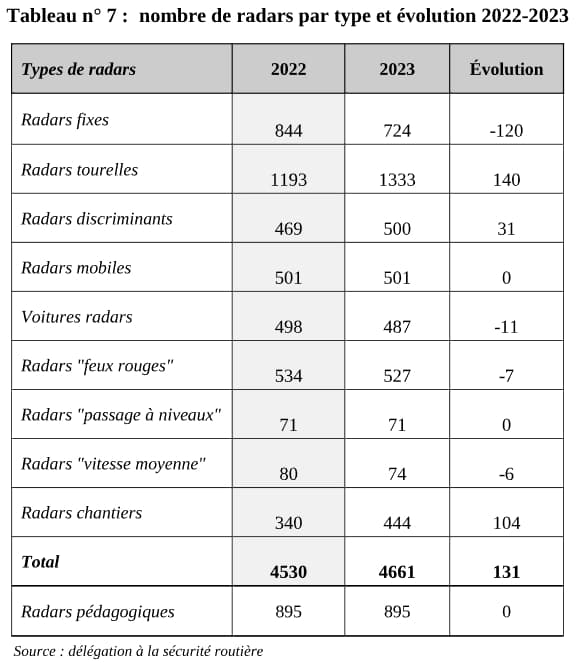2023, a good year for traffic fines. This is indicated by a report from the Court of Auditors, consulted by the specialized site Caradisiac.
More than 2,000 million euros of income
In total, the fines exceeded the symbolic threshold of 2 billion euros of income in 2023, an increase of 7% compared to the previous year. In 2017, the previous record, the amount had approached, but not reached, this figure of 2 billion.
Since then, revenues have decreased, first with the controversial reduction of speed to 80 km/h on national roads and with the yellow vest movement, with numerous destruction of speed cameras. Then, starting in 2020, the Covid-19 pandemic, which had significantly reduced car traffic with the various confinements, caused a mechanical drop in road fines.
The second best result for radars.
The Court of Auditors’ report does not specify the total amount of income from automatic radars in 2023. We simply know that fixed fines, those paid on time, represented 747 million euros of income.
This is the largest amount since 2017 and a record of 825 million euros. Adding the amount of the increased fines (those paid late), the total income from automatic radars exceeded one billion euros for the first time. Which should also be the case in 2023, with a total amount of fines of more than 2 billion euros.
The year 2023 would then represent the second “best” year for automatic speed cameras, combining fixed and higher fines.
Radars increasingly numerous and varied
Main explanation: the number of radars has never been more important.
“The fleet reaches 4,661 devices at the end of 2023, compared to 4,530 in 2022. This is the largest volume of automatic radars deployed since the creation of automated control,” underlines the Court of Auditors.
It should be noted that these are all radars, with a fleet that has evolved significantly last year, as can be seen in the following table.

Tower radars remain by far the most numerous, with 1,333 units, ahead of fixed radars (724), “red light” radars (527), mobile radars (501) and discriminator radars, those capable of distinguishing different types of vehicles (500). .
Construction radars, these famous fixed and mobile cabins, recorded the strongest progression from one year to the next: there are 444, that is, 104 more than in 2022.
We can also add a radar availability rate that has recently improved, Caradisiac highlights. In France, last year there were on average almost 91% of radars operational, compared to around 87% in 2022 and 2021 and falling to 68% in March 2019.
Anti-radar vandalism will be relaunched in 2023
However, vandalism increased again last year, in the context of the movement against the pension reform in spring 2023. The Court of Auditors thus mentions an invoice for repair costs that increased by 3.2 million euros last year, up to 19.6 million euros. 16.4 million euros in 2022. An amount, however, much lower than the peaks reached in 2018 and 2019, with 33 and 36 million euros respectively.
We must also take into account the cost of maintenance, which continues to increase. They were 47 million euros in 2023, compared to 46 in 2022 and 35 in 2021.
“The maintenance of this high level is partly due to the increase in the number of radars, and in particular those whose maintenance costs are among the highest (+140 turret radars, +31 discriminator radars)”, notes the Court of Justice. Accounts.
“The decrease in the number of radar vehicles (-11, to 487 units), whose maintenance costs are by far the highest, makes it possible to contain the increase in maintenance costs,” the report adds.
A car with radar actually represents 40,242 euros in maintenance costs, or 5 times more than the average cost of other types of radars, says Caradisiac.
An increasingly random income level?
The Court of Auditors’ report is also interested in the long-term evolution of these incomes and is concerned about the absence of impact studies that evaluate a possible drop in these unexpected future incomes due to “external factors.”
“Factors linked to climate change and associated policies could lead to restrictions on the use of road vehicles,” the document reads. A particular reference to the establishment of low emission zones (ZFE) that should limit car use in the main cities of France.
Among the reasons that could also reduce the number of flashes are the downward trend in the average speed in France in recent years and the fact that the French are driving less and less: 10,830 km on average in 2022, compared to 14,000 km in 1995.
Source: BFM TV

